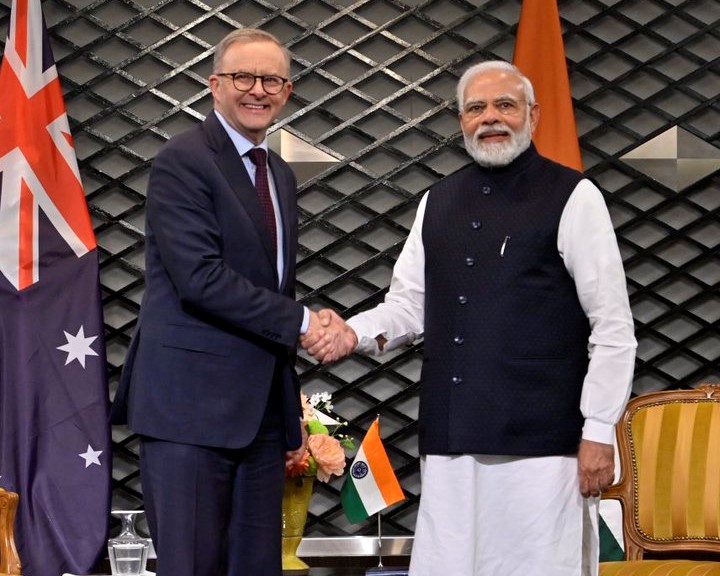Prime Minister Anthony Albanese’s visit to India this week comes at a pivotal moment for Australia’s ties with that country. Over the past 15 years, the two have overcome decades of mutual indifference and built a promising strategic partnership. The challenge now is to consolidate those gains and realise the potential of the relationship.
This will not be easy. To be sure, Australia and India have common concerns and our people-to-people ties are burgeoning. Both countries are worried about China’s ambition and assertiveness in the Indo-Pacific. Both are keen to see the growing Indian diaspora in Australia flourish. More than three-quarters of a million people of Indian origin – students and skilled workers – now call Australia home.
These shared interests are important, but in themselves they are not sufficient to deliver a robust partnership. There are other like-minded states with whom Australia and India might collaborate to manage Beijing’s behaviour. And diasporas, however enterprising, can and often do complicate relations between governments.
The first step towards getting the partnership on the right track is recognising that strong ties with India are not inevitable, despite shared anxieties and cultural connections. The second is acknowledging that even during the past decade and a half, the relationship has ebbed and flowed, and appreciating the reasons why.
One major problem is that Australian and Indian politicians and officials simply do not know enough about each other’s country. In Canberra, only a handful of MPs and bureaucrats know India well. The situation in New Delhi is much the same.
This lack of understanding has serious consequences. Official statements get misconstrued, intentions misread, and capabilities under- or over-estimated. Such errors, in turn, feed the sceptics and critics on both sides, who question the wisdom of the strategic partnership in public and private.
Another difficulty is that the relationship remains overly dependent on the personal commitment of prime ministers. We have seen this clearly over the last decade. Under Tony Abbott and later Scott Morrison, the strategic partnership moved forward, thanks to their enthusiasm and personal diplomacy with India’s prime minister, Narendra Modi. Under Malcolm Turnbull, it did not, reflecting the concerns he later detailed in his memoirs about India’s political and economic trajectories.
On the Australian side, however, perhaps the biggest obstacle remains uncertainty about what Canberra hopes to achieve with India. The Abbott and Morrison governments sought to enlist New Delhi in a values-based Indo-Pacific coalition principally aimed at China. More prosaic objectives are outlined in recent Defence and Foreign Policy White Papers, including broader security cooperation in areas such as upholding freedom of navigation, boosting trade and investment, and collaboration in science and technology.
The Albanese government has already gone a long way in reassuring New Delhi that the new administration values the relationship. It has signalled that Australia wants to work with India bilaterally and in other forums. The prime minister’s post-election dash to the Tokyo Quad summit in May 2022, made with Foreign Minister Penny Wong, was well received. So too was Defence Minister Richard Marles’ well-publicised trip to India the following month and the flurry of ministerial visits since.

The government has also advanced or unveiled a series of other initiatives since coming to power last year. It is promoting the benefits of a trade agreement signed in the dying days of Morrison’s term. It is pushing ahead with a new Centre for Australia-India Relations, which will have some $20 million to spend on engaging the Indian diaspora and building cultural ties between the two countries. It has indicated that Australia is keen to work more closely with India on climate change and renewable energy.
More still needs to be done. Albanese will no doubt use this visit to establish a strong rapport with Modi. This makes sense: the Indian prime minister will likely remain in power for the next five years, if not the next decade, and is the key to effective cooperation. India’s over-stretched bureaucracy moves on Modi’s direction. Making deals with India and implementing them depends to a large degree on winning his confidence.
To consolidate the strategic partnership, this visit will also have to begin to answer the questions of what Australia wants from New Delhi and how India fits into Canberra’s strategic vision for the Indo-Pacific.
Rightly, the Albanese government has prioritised strengthening ties with Southeast Asia and the Pacific, and “stabilising” the relationship with China during its first months in office. But India – along with Japan and the United States – is key to establishing what the foreign minister terms a “strategic equilibrium” in the Indo-Pacific. Without India’s growing economic and military power, we will struggle to manage Beijing’s ambitions. Without India’s diplomatic influence, we will find it harder to persuade some of the smaller states of the region to do what they must to ensure regional security and prosperity.

